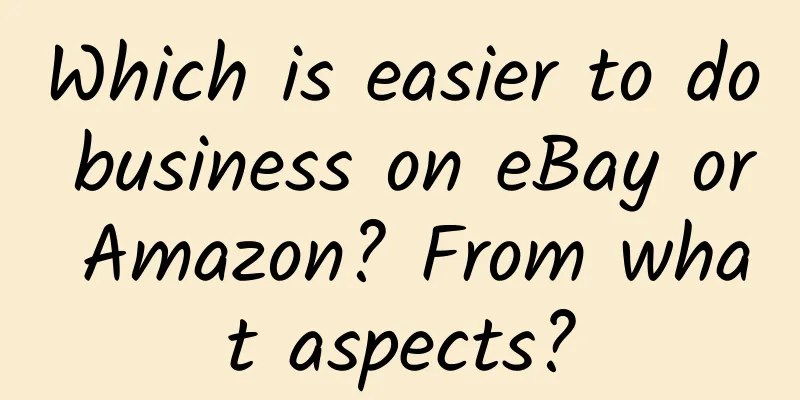Which is easier to do business on eBay or Amazon? From what aspects?

|
Amazon is the world's largest cross-border e-commerce platform, and eBay is also a cross-border giant. Many sellers hesitate and hesitate between Amazon and eBay. So how should they choose between eBay and Amazon? 1. Amazon sellers vs. Ebay sellers Amazon is the go-to platform with high brand awareness, fast delivery times, and excellent customer service. But as more sellers jump on the platform, competition is getting more intense. This means that customer expectations are also increasing. Overall, this competitive landscape means that the types of sellers on the Amazon platform are becoming increasingly high-level. eBay sellers have a wider range. Unlike Amazon, there are no big brands on the platform. While Amazon sellers struggle with high customer expectations on the Amazon platform, eBay sellers are the opposite: some items on eBay are used or second-hand. eBay also attracts different types of customers, which makes some products more popular than others. 2. Competitiveness: eBay vs. Amazon Back in 2007, Amazon itself was selling 74% of products, but by 2015, Amazon’s products were only 56% sold by third-party retailers on its site, and by 2017, it was about 50/50. Going into 2018 Amazon’s sales were down to 48%, and despite the popular opinion, the scales seem to be tipping in favor of third-party sellers. But just because Amazon's sales are down doesn't mean they're not as competitive as they once were. "There's no guarantee they (Amazon) won't take advantage, and in some cases they may have. They can sell their accounts, they can see what's selling and what's not, and that puts [Amazon] in a powerful position," said James Dunford-Wood, an e-commerce data expert at Ometria. From a seller’s perspective, “you compete with sellers and Amazon.” Amazon is well known for selling new products and tends to favor larger brands and retailers, such as Amazon's own 'brand' niNiker. Many times Amazon uses smaller retailers to identify trends and niches and then pushes them by undercutting and undercutting them. Amazon even has a list of restricted brands that sellers have to pay a fee to sell: With this in mind, Amazon is a great marketplace for people to sell solid private label products, and their intense competition ensures that most of the best products with excellent customer service and quality can be sold on their site. On the other hand, eBay has a reputation as a marketplace that primarily sells used goods and collectibles - the ultimate online garage sale. Here's a fact that might surprise you: 81% of items sold on eBay are brand new! Either way, eBay itself doesn’t have its own brand, nor does it try to use its sellers as guinea pigs to steal their business — it’s purely an e-commerce platform. Beyond that, eBay as a marketplace provides a much better platform than Amazon for small sellers to build their brands. The bottom line is that Amazon is a more competitive marketplace for individual sellers and tends to favor newer merchandise, whereas eBay offers sellers the ability to build brand identity while the majority of merchandise is new, and it provides a niche for older items and collectibles. Amazon Customers vs. Ebay Customers 1. Amazon customers According to Statista, Amazon is the most popular online store in the United States. It has by far the largest market share in e-commerce. So who are these Amazon customers? Compared to customers on other e-commerce platforms, they are generally better educated and more affluent than the average American. Here are three of the most distinctive characteristics of Amazon customers: Younger. More than 50% of Amazon shoppers are under the age of 45, according to Digital Commerce 360. Prime customers tend to be younger than the average Amazon shopper, with 18-34 being the most significant age group. High income. Amazon customers are predominantly male and tend to have higher incomes. Amazon accounts for 90% of shoppers with incomes between 500k-100k and 89% of shoppers with incomes of 100k+. Even for shoppers with incomes below 50k, Amazon still has 73% of the market share. High spending. Prime members are particularly enthusiastic about Amazon’s free 2-day shipping and tend to buy more than non-Prime members. With 64% of U.S. households having a Prime membership, this means Amazon customers are spending more than ever on the platform. Amazon has the majority of US shoppers, especially those under 45, with more than 50K. And, because their customers are affluent, their expectations are higher. This is especially true for Amazon’s largest shopper, Prime members. 2. Ebay customers While not as popular as Amazon, eBay is still a big player in the e-commerce space. According to Statista, “eBay had 171 million active users in the first quarter of 2018.” While smaller than Amazon’s customer base, 171 million users is still certainly significant. Here are the most distinctive eBay customers: Older. eBay customers tend to be older than Amazon customers, with 61% over the age of 45. Like Amazon, they tend to be mostly male. Middle income. While the exact income range of eBay customers is difficult to determine, it appears to be generally lower than the average income of Amazon customers. eBay customers also tend to pay less for the items they want. While Amazon is more competitive on price, customers, especially Prime customers, seem willing to pay more for the convenience of 2-day shipping and a broad catalog. Overall, eBay remains a larger marketplace that is more popular with older shoppers, especially those over 45. Since their customers tend to be of average quality, they are more motivated to find the best deals and pay less for the items they are looking for. Ebay and Amazon both have their own characteristics. As a seller, you need to choose according to your own environment and resources. The above is the content of Amazon and eBay in this issue. If you want to get more relevant information, please continue to pay attention! |
<<: What are the main categories of products sold on eBay?
>>: The correct way to sell products on eBay’s US official website!
Recommend
Who will audit Disney's factory inspection?
Disney's audit and application have the follow...
eBay website address and how to shop on eBay?
The website of eBay is: http://tieba.baidu.com/f?...
eBay platform classroom, what are the characteristics of eBay?
As an international retail cross-border e-commerc...
Social Responsibility Compliance Audit Checklist (I)
Carrefour (logo) Factory name: XX Toys Co., Ltd. ...
Is it reliable to buy things on eBay? How to choose a reliable seller on eBay?
A reader asked me if it is reliable to buy things...
What is Tinkleo? What services does Tinkleo provide?
What is Tinkleo? Tinkleo is an export B2C integra...
Several important things to keep in mind during factory inspection
1. Legality The legality of the enterprise is the...
How is Bar-headed Goose? What are the service advantages of Bar-headed Goose?
How about the bar-headed goose? Founded in 2018, ...
Ann Taylor Factory Inspection Safety and Health Work Guidelines
Ann Taylor Factory Inspection Safety and Health W...
What is Taikuai Logistics? What services does Taikuai Logistics provide?
What is TaiKuai Logistics? Shenzhen Taikuai Logis...
Cross-border e-commerce has become a new driving force for Tianjin's foreign trade transformation and upgrading
Cross-border e-commerce has become a new highligh...
How to Promote Your eBay Store?
1. Promote your store on eBay 1. Promote your sto...
RepricerExpress--eBay pricing tool
RepricerExpress is an excellent tool that can hel...
FSC forest certification - a hot topic of international concern.
As a new mechanism to promote sustainable forest ...
What is FOB fee? How to calculate FOB fee?
What is FOB fee? FOB is one of the commonly used ...









